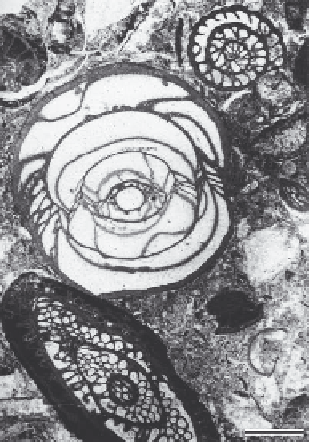Geology Reference
In-Depth Information
Plate 68 Late Paleozoic Larger Foraminifera: Fusulinids
This plate exhibits characteristics in the morphology and wall structures of Fusulinids of different ages.
Fusulinids were benthic rock-forming larger foraminifera with a restricted geological range (Viséan to latest
Permian), a wide geographic spread and distinct evolutionary lines allowing global biostratigraphic zones to
be defined.
The mm- to cm-sized tests have spindle-like, subcylindrical or globose shapes (Fig. 10.26). The complex
internal structure is caused by variations in coiling, folding patterns of the partitions between chambers (septa)
and additional elements projecting from the walls into the chamber interior (-> 9). The walls are microgranular
and appear dark in transmitted light and opaque in reflected light. They consist of one to four layers (-> 2, 4, 6).
Pores occur within walls and septa (-> 4). The determination of fusulinid species requires sections in the axis of
coiling and passing through the initial chamber (-> 1, 3, 5) and cooperation with micropaleontologists. How-
ever, even nonspecialists can use these foraminifera for a very rough dating of shelf carbonates, if they look at
the wall structure type. The wall structures increase in complexity over
time, starting with relatively simple multilayered walls (-> 2) in the Early
and Middle Carboniferous, and continuing with double-layered walls (->
4) characteristic of Late Carboniferous and Early Permian Schwagerinids
(-> 3). Middle and Late Permian Neoschwagerinids have two-layered
walls and shorter and longer projections into the chambers forming small
chamberlets (-> 6). Most fusulinid families became extinct near the end
of the Middle Permian (Guadalupian), the last Fusulinids at the Permian-
Triassic boundary. Late Permian taxa are usually small and often charac-
terized by distinct deviations in the coiling planes during individual growth
(-> 7, 8).
Fig. 10.26.
Mixture of spherical and spindle-shaped fusulinid shells
derived from
different subenvironments. Poorly sorted bioclastic grainstone of an outer car-
bonate platform. The large spherical test (
Zellia heritschi mira
Kahler and Kahler)
is cut through the initial chamber. Spindle-shaped forms are represented by two
sections cutting the tests tangentially (bottom) and transversially (top). Spindle-
shaped tests are peripherally micritized and often broken. Early Permian (Asse-
lian): Carnic Alps, Austria. Scale is 1 mm.
1
Beedeina
Galloway. Axial section of the fusiform test. Note the initial chamber (proloculus; center) and the strongly
fluted septa. Generic range: Middle to Late Moscovian. Middle Carboniferous (Moscovian): Kalinovo, Donets Basin,
Ukraine.
2
Beedina
sp. The wall structure exhibits four parts: Dark tectum (t), light diaphanotheca (d) bordered by the upper tecto-
rium (ot) and lower (ut) tectorium. Same locality -> 1.
3
Sphaeroschwagerina carniolica
Kahler and Kahler. Axial section of the spherical test. Note difference between the
dimensions of inner and outer whorls. The thin septa are weakly fluted. Wall thin, thickening as the test enlarges. Species
range: Early Permian. Asselian (Grenzland Formation): Rudnigsattel, Carnic Alps, Austria.
4
Sphaeroschwagerina carniolica
Kahler and Kahler. Wallstructure: Tectum (t) and 'honeycomb-like' alveolar keriotheca
(k). The septum (s) is pierced by septal pores (sp). Same locality -> 3.
5
Yabeina syrtalis
(Douvillé). Axial section of the inflated fusiform test. Note the abundance of whorls, numerous rela-
tively thin septa and short septula (-> 6). Middle Permian sponge-algal reef (Wordian): Bati Beni section, Djebel Tebaga,
southern Tunisia.
6
Yabeina syrtalis
(Douvillé). Wall structure consisting of two parts: tectum and keriotheca. The chambers are subdivided
by parachomata (pch) and transverse septula (ts) and filled with granular carbonate cement. Same locality -> 5.
7
Reichelina
Erk characterized by a marked difference between an early planispirally enrolled stage and uncoiled final
whorl with septa. Late Permian (Wargal Formation, Wuchiapingian): Chidru Nala, Salt Range, Pakistan.
8
Codonofusiella
Dunbar and Skinner. Note sharp change in coiling axis. Same locality -> 7.
9 Random cuts: Microfacies thin sections commonly yield only randomly cut tests which are difficult to treat taxonomi-
cally. But sometimes specific structures are sufficient for a rough determination. Example: The broad and regularly
spaced transverse septula indicate a neoschwagerinid form and points to a Middle Permian age of the sample. Middle
Permian: Bohinska Bela near Bled, Slovenia.
10 Random cuts: Sagittal section (perpendicular to the axial section and passing though the initial chamber) and tangential
section of fusulinids. Note deformation of the last whorl of the left specimen (arrows) pointing to a pathological distur-
bance of shell growth rather than a mechanical destruction (Kahler 1988). Same locality as -> 9.
-> 1-8: Courtesy of H. Forke (Erlangen)

